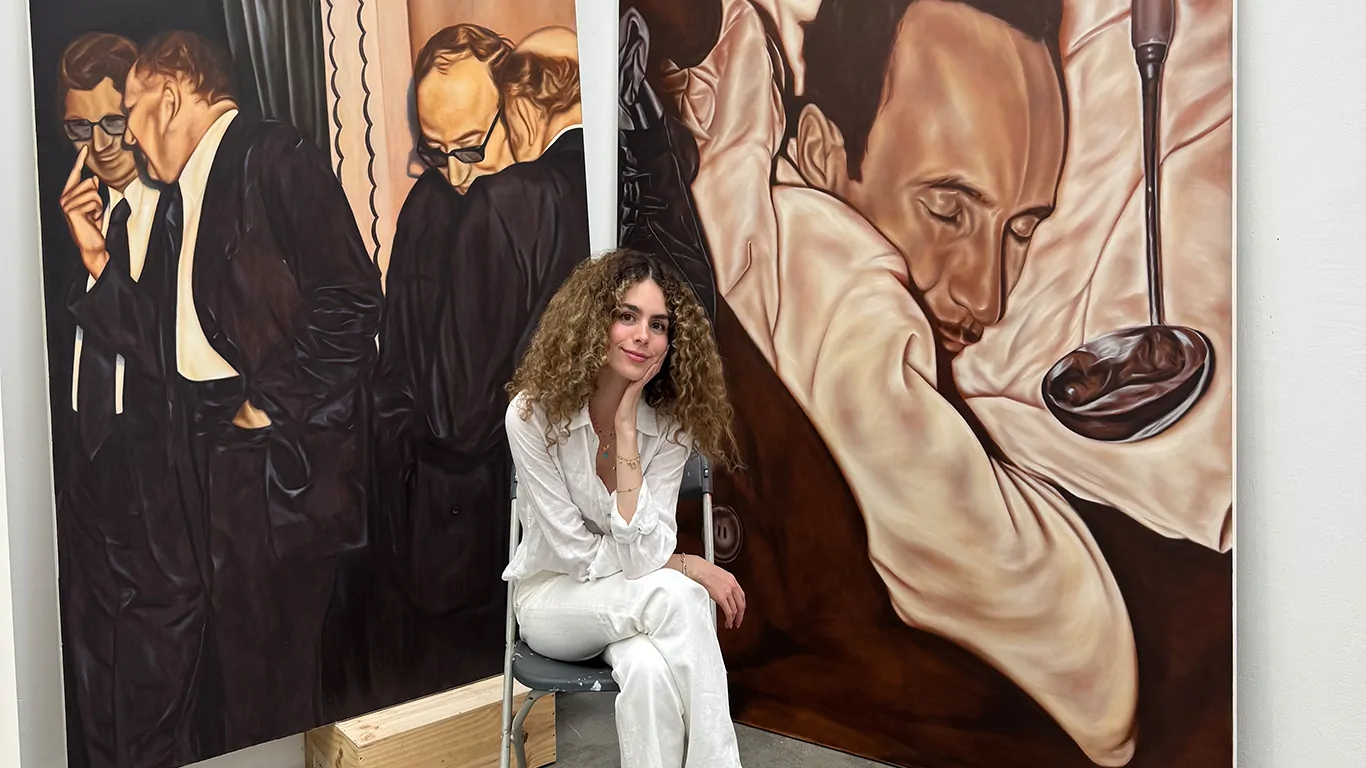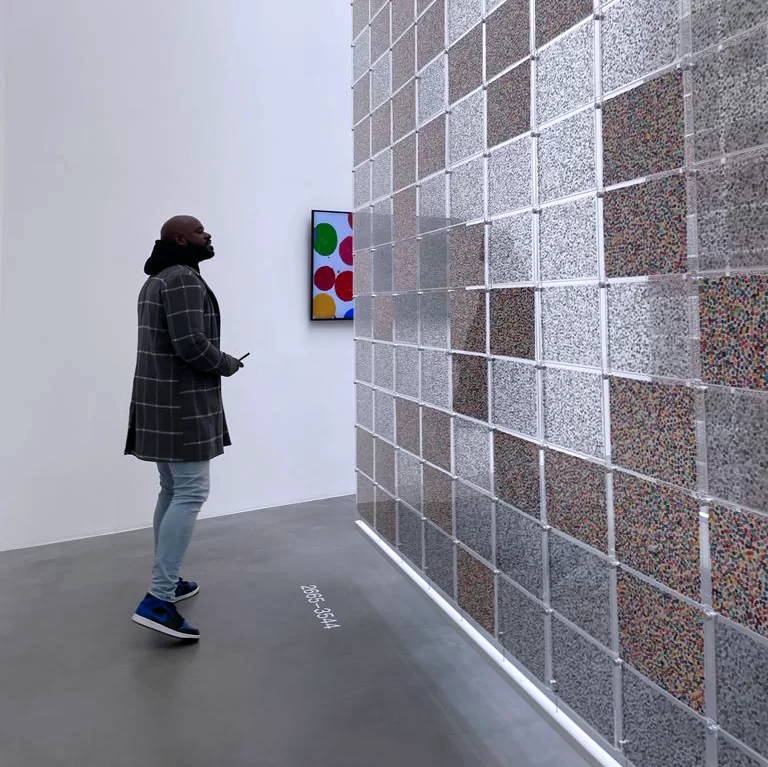Tracing Memory Through Oil and Archive: Tiyana Mitchell’s Intimate Portraits Across Place and Time
Rendered with the smooth, near-photographic realism of the Old Masters, emerging artist Tiyana Mitchell paints from the film of memory. In her first UK solo exhibition, Conversations Across Time, now on view at Larkin Durey, images emerge the way memories do—fragmented, elusive, suspended between presence and absence.
Mitchell draws her source material from her late grandfather’s photographic albums, which trace her family’s life across the Middle East and his travels in Europe. Many were carefully labelled; others, discovered after her grandmother’s passing, arrived without names or dates. These unlabelled photographs—mute but suggestive—became central to Mitchell’s practice. Rather than seek definitive answers, she treats them as open-ended prompts, painting what she describes as ‘a memory that isn’t entirely mine’.
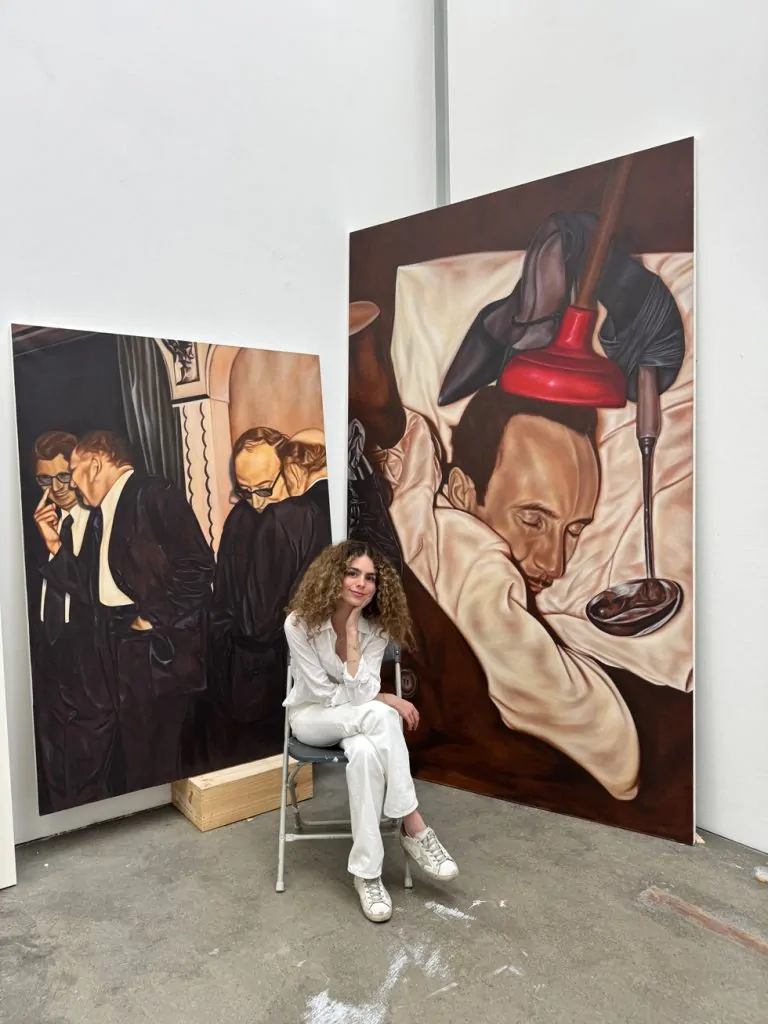
Credit Natalia Baranowska
I am attempting to reconstruct a memory that is not my own. I am piecing it together through the conversations I had with my grandmother.
Tiyana Mitchell
The idea took root after a chance encounter in New York, when a stranger mentioned knowing her grandfather—a man Mitchell had barely known. That brief exchange sparked a deeper search. Online, she eventually found part of her family archive on the Arab Image Foundation website. When travel restrictions lifted, she returned to Jordan to sit with her grandmother and the albums, attempting to trace what had long remained unspoken.
Mitchell’s paintings are composed through a process of cropping and isolating. A folded sleeve, a shadowed glance, or the tension between two partially visible figures becomes the new centre of gravity. The effect is meditative and elusive: familiar yet unknowable.
Having studied at the Royal College of Art in London, Mitchell works in oil on linen, transforming ephemeral snapshots into immersive, slow-burning images. Where her grandfather sought clarity and order in assembling his albums, Mitchell embraces the ambiguity they leave behind.
Her work resists nostalgia. Some images lean towards the playful—like a cousin asleep, encircled by prankishly placed objects. Others include unnamed political figures, placed without context beside family portraits. Mitchell maintains this dissonance, collapsing the boundary between the personal and the historical.
‘Art without a story is just decoration’, producer Rick Rubin once said. Mitchell’s paintings bear this out. They are not decorative in the traditional sense. They are acts of narrative enquiry—attempts to recover, reframe and sometimes let go.
She describes her practice as a dialogue with her grandfather, one that spans time, geography and medium. His images were whole; Mitchell’s are fragmented. Yet together, they form a new visual language—one that reflects the instability of memory itself. As such, her scenes resemble film stills—framed on canvas, uncertain in meaning, yet impossible to look away from.
In Conversations Across Time, Mitchell does not attempt to reconstruct the past so much as she listens to it. Her canvases, rendered in oil on linen, echo the muted tones of aged prints. The stories they hold remain incomplete—and that is precisely the point.
We spoke to the artist during her exhibition at Larkin Durey in London, where she reflected on the origin of the project and the process of translating personal archives into painted images.
You’ve lived between the US, Cyprus and Jordan — how does this peripatetic upbringing shape the way you see images, and the way you reconstruct memory through painting?
Tiyana Mitchell: I think my upbringing informs the sense of piecing elements together in my work. It has also influenced how I approach choosing certain elements from the archive, which itself draws from many cultures. While the albums are primarily in the Middle East, they contain images from all over the world. I also have a sense of being rooted when I look at these albums and into my family’s past, trying to understand who they were. I am always exploring how I might depict such special images through a painted format.
Your journey began with a chance encounter with someone who knew your grandfather. What was it about that moment that compelled you to begin excavating your family’s visual past — and ultimately painting it?
Tiyana Mitchell: I think having just moved to a city like New York from Cyprus where everyone knows everyone, I didn’t expect someone to know my grandfather (my Sido). It sparked this curiosity in me about his life although I had always been fascinated by the photos my grandparents kept on the walls of their home.
The sense of familiarity that this person had when speaking about my grandfather and his humour is something I’ve tried to reflect in the current body of work at Larkin Durey. Painting was my way of giving the photographs a sense of permanence.
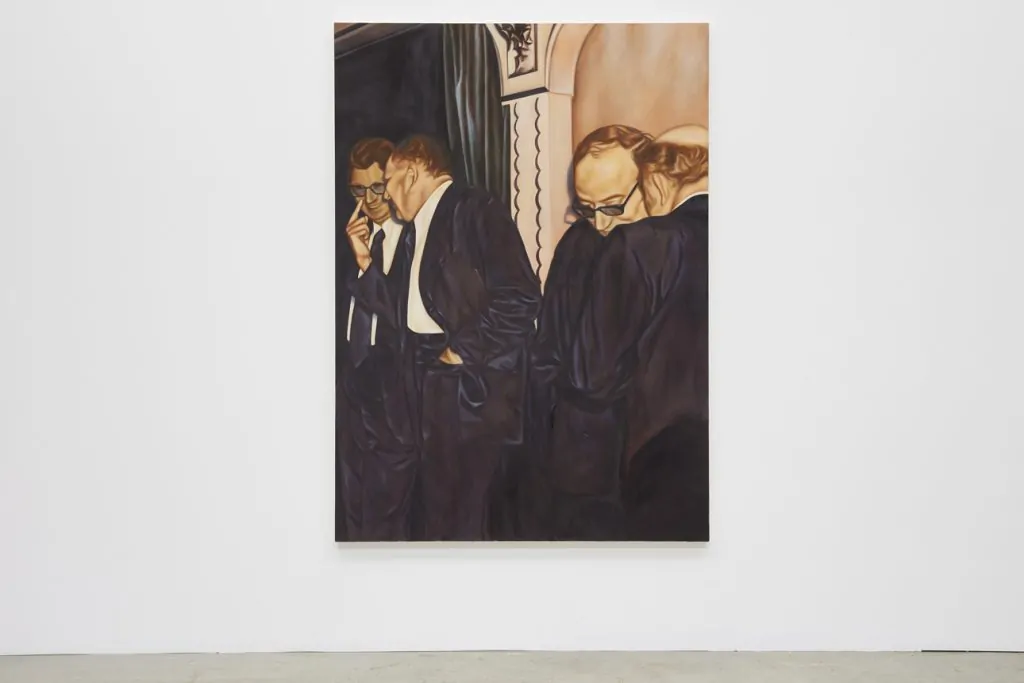
Album 2: Marrakesh: 1974: 1, 2024
Oil on Linen
70 7/8 x 51 1/8 in
180 x 130 cm
(03365)
Much of your work is in dialogue with photographs taken by your grandfather. Do you see your paintings as collaborations with him, or are they more acts of reclamation and reinterpretation?
Tiyana Mitchell: I feel the paintings are somewhere between a collaboration and reinterpretation. Naturally I am drawn to aspects of these images that are different from how he would have viewed his photos. I look at the folding of the suits, the shoes, these moments of tension and mystery between people, where his focus may have been more on the holistic image. In terms of reinterpretation, what I do does remove the image from the original context to a large extent.
My grandfather was very meticulous with how he put the albums together, and me going in and taking certain aspects does go against this. I feel this is where the dialogue begins. The photographs that I have started to take as reference material for the paintings also situates the work in a more contemporary context.
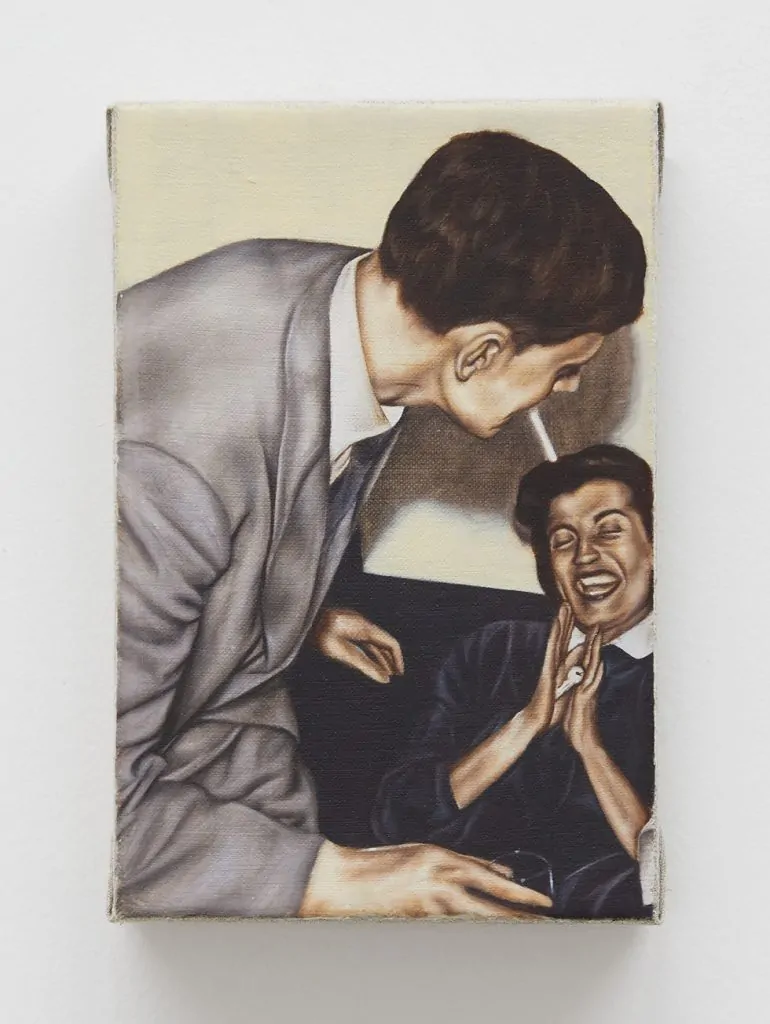
Album 8: London: 1940’s: 2, 2025
Oil on Linen
5 7/8 x 4 in
15 x 10 cm
(03370)
The photographs discovered after your grandmother’s passing were unlabelled and enigmatic. How did that absence of information influence your approach — emotionally and artistically?
Tiyana Mitchell: The unlabelled photographs make the research of the work very interesting as it reflects this piecing together element that I have in the final paintings. I love having to dig through and search for information as I always learn a little bit more along the way, about my family or the history of the region.
I also occasionally receive a message regarding locations of the original that I may have thought was in one place was actually in another. It adds another layer to how fragmented the history is, and how the paintings can amplify this aspect. Most of the work is informed by absence rather than what is there, either by the fact that the information does not exist, or that I have chosen not to disclose it.
You often crop and isolate fragments from archival photos. What draws you to particular moments or figures? Is omission, for you, a poetic act — or a political one?
Tiyana Mitchell: I find the most interesting moments to be when you are not fully aware of what is happening; that little moment of mystery right before something is revealed. There are so many overlooked elements in the photographs of people having a discussion or with looks on their faces that make me wonder about the context of their interaction.
Painting these gives a sense of importance to these lesser seen moments. In some ways, I also feel quite distanced from the images in the albums. While they are of my family, it’s been a journey of uncovering a history that I was not fully aware of so cropping and isolating the fragments reflects my own distance from what I am seeing.
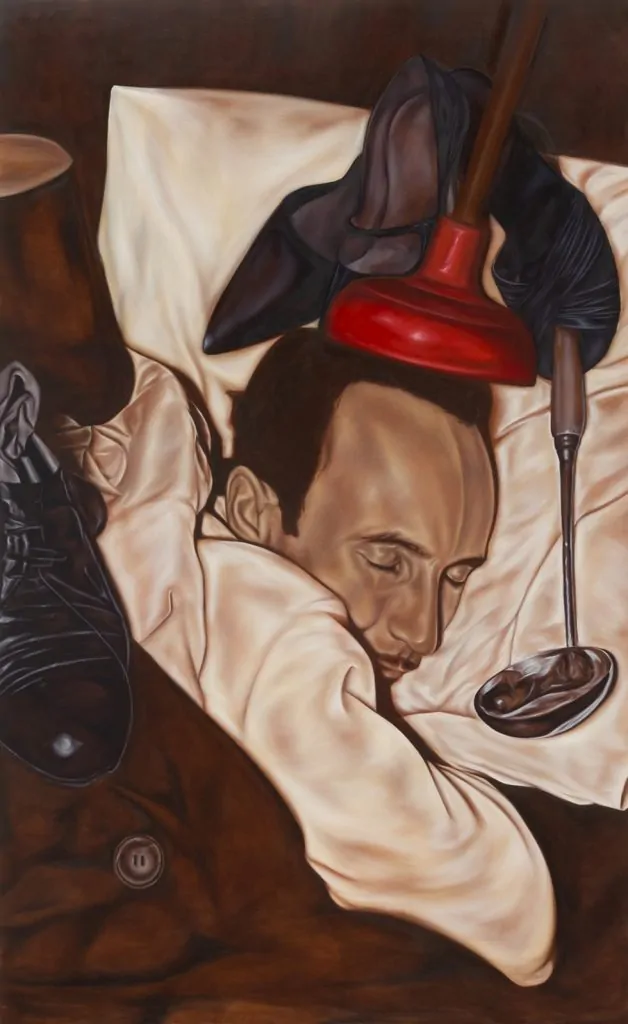
Album 1: Ramallah: 1940’s: 1, 2025
Oil on Linen
102 3/8 x 63 in
260 x 160 cm
(03364)
Your paintings seem to hover between revelation and concealment. How conscious are you of creating that tension — that sense of ‘peering into something that shouldn’t be seen’?
Tiyana Mitchell: That very tension is what guides the work. The mystery that surrounds each image adds to its story. I then lean into cropping and isolating elements of the photographs to further push the fragmented nature of the work and its history. The figures and social scenes feel at a distance. I also want the paintings to relay the sense of wonder I had when opening the albums for the first time. Every time I open the albums something catches my eye.
There’s a haunting dissonance in your work between what is shown and what remains hidden. Are you trying to reconstruct memory — or unravel its reliability altogether?
Tiyana Mitchell: I am attempting to reconstruct a memory that is not my own. I am piecing it together through the conversations I had with my grandmother (my Teta) while we looked at the albums together before she passed away, the stories from my mother and my aunts, as well as what I could glean from online sources and history books. My work is about fragmented memories and stories placed together in an attempt to recreate a past that is itself not complete.
By fragmenting and recontextualising images, you reveal the instability of photographic memory. Do you see the archive as a fixed record, or something more spectral and shifting?
Tiyana Mitchell: I am quite interested in false memories and how these can affect the perception of reality. The paintings are my grandfather’s memories through my eyes but I try to keep as much of my grandfather’s original intent within the final painting.
I see the archive as quite fixed and aim to maintain the integrity of my grandfather’s images while recontextualising them. I have found that through deliberate cropping I am able to drastically alter the image and its perception, finding my own narrative within them, while maintaining much of the original aspects. I look for ways to create a sense of unease in the paintings, where everything feels slightly incorrect in order to illustrate the malleability of memory.
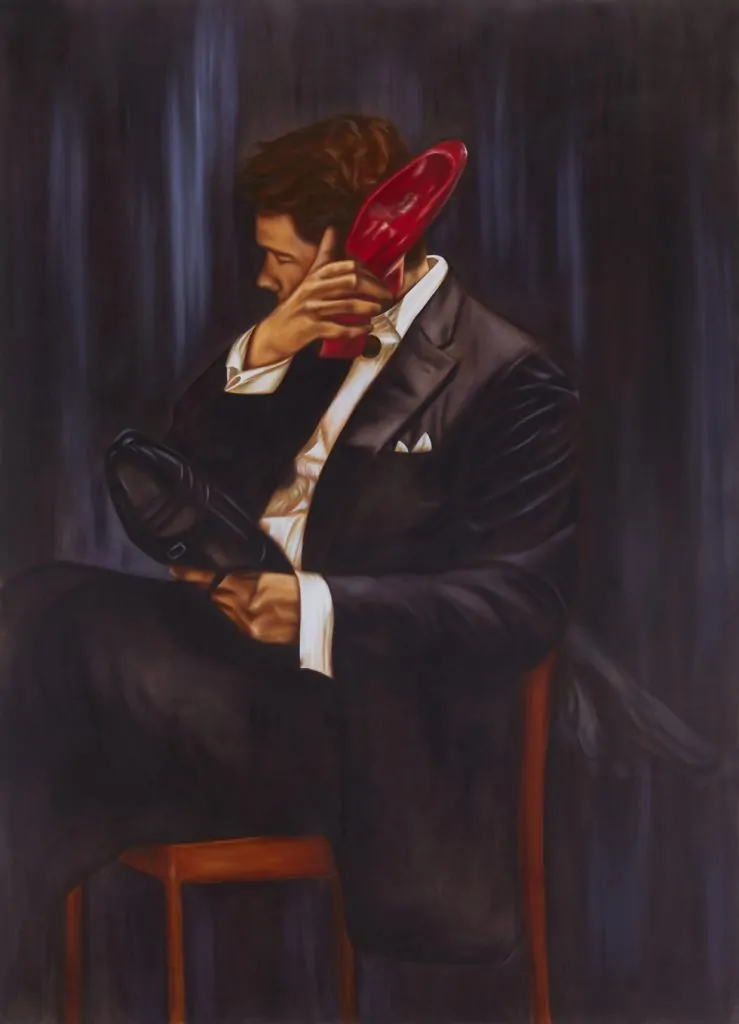
Roll 8: London: 2024: 8, 2025
Oil on Linen
70 7/8 x 51 1/8 in
180 x 130 cm
(03366)
You work from analogue photography but paint in oil on linen. What does this shift in medium allow you to express that the original image cannot?
Tiyana Mitchell: There is a lack of permanence with a photograph, they are fleeting moments. While they show reality, they are also the residue of what happened. With the paintings, the scale and cropping challenges how permanent the image is. My larger works immerse you in the world of the image and yet there is a barrier that stops you having full understanding of the original.
The paintings also give new life to the photographs that would otherwise be hidden in albums. As well as rearranging the narrative by placing sections of images together, I also take my own images as reference material for paintings. I use a 500c/m hasselblad from the 1970’s and a Leica MP, which has the same mechanisms as the Leica my grandfather used. When these posed scenes are transferred to oil and shown alongside paintings from my grandfather’s archive, I am able to change how time is perceived in the work.
How has studying at the Royal College of Art — and being based in London — influenced your practice, especially while working with imagery rooted in the Middle East?
Tiyana Mitchell: My grandfather studied law in London and that shared sense of place has made me feel closer to the images. Painting his photographs in London feels surreal and touching. The Royal College of Art has really allowed me to explore working with the original image in a way that I wouldn’t have been able to do alone.
I’ve really pushed that feeling of peering into something that maybe shouldn’t be seen. I’ve also been scanning the original albums to further preserve them.
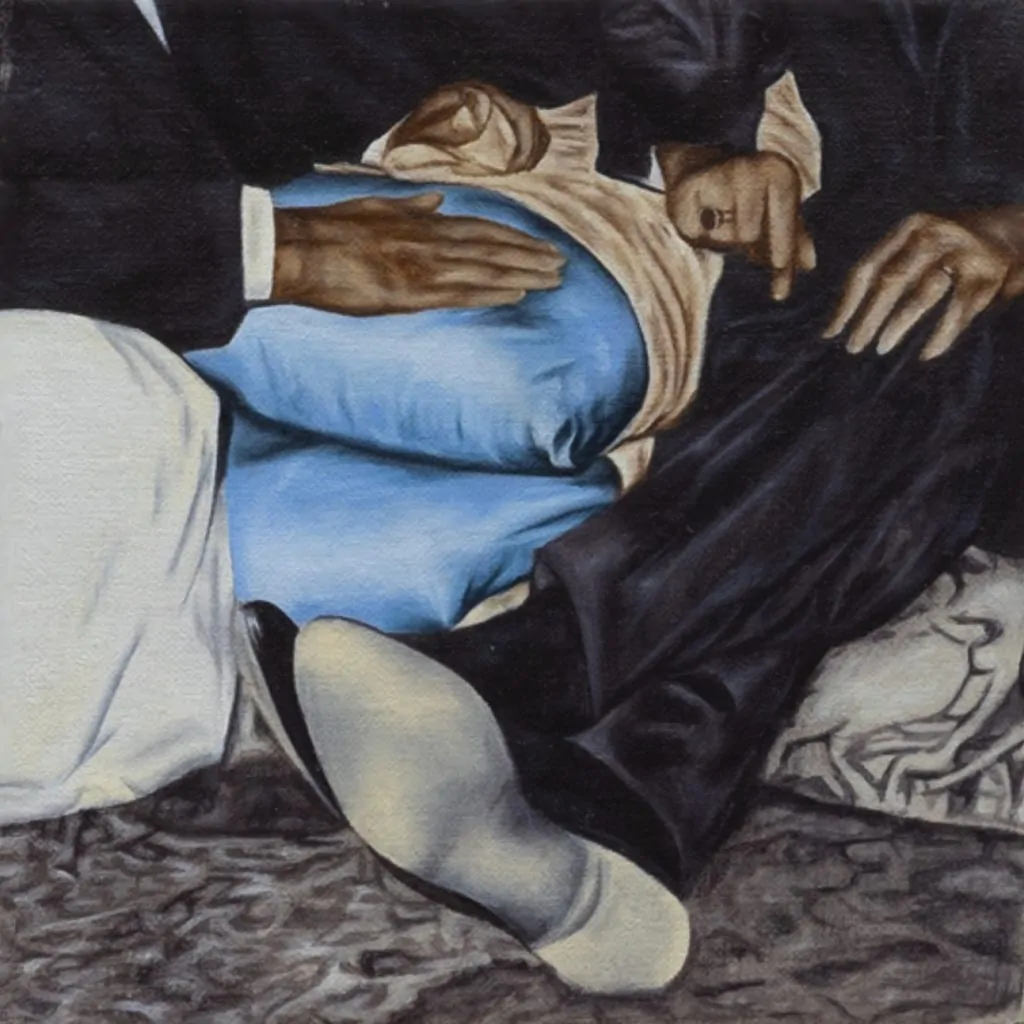
Album 6: Amman: 1960’s: 1, 2025
Oil on Linen
4 3/4 x 4 3/4 in
12 x 12 cm
(03372)
Your show Conversations Across Time feels deeply personal but also politically resonant — especially in this moment of global displacement and archival re-examination. How do you navigate the space between personal story and broader political implication?
Tiyana Mitchell: The albums fall between the personal and political; family photos sit alongside images of political figures. You’ll find an image of my mother and political dignitary next to each other. There is no relationship between the images, my grandfather just decided to arrange the albums this way. Navigating this has been interesting.
In my current show, there is a painting of politicians, but you may not realise this unless I tell you which one it is. Another piece is of my grandfather’s cousin who fell asleep while my grandfather was there and decided to decorate all around him with shoes and a plunger. This back and forth between the humorous and political or formal is what fascinates me about the albums and what I wanted to reflect in this exhibition.
©2025 Tiyana Mitchell


